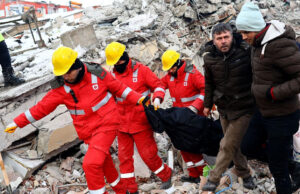Be prepared: Earthquake threat remains

Recently, there was word that a huge earthquake, with a possible magnitude of over 7, was coming on October 3-4. For those who don’t know much about earthquakes, that is a huge one. But October 4 has come and gone, and fortunately we are still here. However, this prediction has made a lot of people nervous. Earthquakes are very common here in California.
The San Andreas fault that runs through California is 800 miles long, and would do a huge amount of damage if the tectonic plates that make up the fault touch. So people are right to be nervous. The tectonic plates in Southern California have not collided in around 330 years. Usually, a huge earthquake happens every 100-250 years, which means a massive earthquake here in Southern California is way overdue.
Although the threat of a massive quake has passed, many people have started to realize that a huge earthquake could come at any minute.
Scientist have predicted, with a 99 percent probability, that an immense earthquake will happen in the next 3 years (http://inhabitat.com/nasa-experts-say-californias-next-big-earthquake-could-happen-in-less-than-three-years/ )This would devastate many homes and families. The best way to prevent countless deaths that could happen is to always be prepared for the unexpected. Just to be safe, some have made emergency kits
Earthquakes are frightening, and life-threatening. Which is why there are countless websites and companies that are here to help for the preparation of an emergency kit that will help in times of need. Californians do not have to live in fear.
Kyle Yasui, a student at Newbury Park High School, was tested on his knowledge on earthquakes and how to prepare for them. “I know that they are caused by the shifting of the tectonic plates and the tectonic plates create fault lines. That’s where most earthquakes occur.” Yasui is one of the many who have prepared an emergency kit. His includes “some canned foods, water bottles, a flashlight, a miniature radio thing, and I think that’s about it.” If a big emergency was coming, he would add blankets and a portable charger for his phone.
Scientists have been predicting a huge earthquake for a long time. Now that there has been a threat of an earthquake for such a long time, people are not as alarmed, which although is a good thing, it also means they will not be prepared for when there is an actual emergency. Thankfully, “we’ve learned how to deal with earthquakes in schools” and at some homes it is “discussed just in case”. Yasui is not very scared about an earthquake for this reason.
Brianna Harris, Biology teacher at Newbury Park High School, is also not too scared. Having been in elementary in Oxnard at the time of the Northridge earthquake, Harris knows how traumatizing earthquakes can be. However, at that time, scientists were saying “that california was going to break off, and float into the ocean, and there were all these things about tidal waves”. This contributes to her skepticism about what scientists have been saying about an earthquake happening soon.
Harris has had more experience with natural disasters than most people. Having lived in Florida for years before teaching at Newbury, where there are many hurricanes, she knows the dos and don’ts of an emergency.
She recalls that “there were certain things I remember growing up that we always did… we would want to find the safest room in the house and go there if you thought there was an earthquake coming.”
In preparation for a disaster, as hurricanes are easy to predict, “We would buy lots of water, lots of nonperishable foods, applesauce, just other things that won’t spoil.” This relates to earthquakes and other disasters, as one never knows how long they could be stuck in their house.
Another tip she learned was “any time the power was out, don’t open the fridge… because you’re going to let out cold air that you can’t get back if the fridge isn’t plugged in so you want to keep things cold as long as possible.” Opening the refrigerator was a last resort.
Harris remembers that water was very important as well. When in doubt, make sure you have water.
Lisa Keatts is another expert on emergencies. For ten years, she had an online store, fuelforadventure.com. This store had “mostly outdoor gear, and camping supplies, and I also had some emergency supplies on there.” Just last year, Keatts started an online emergency kit store, emergencykitsandsupplies.com. She sells kits that will prepare you for almost anything. Some of the many kits Keatts sells are winter kits “for people to put in their cars so if they ever broke down and it’s freezing cold”, hurricane kits, and lockdown kits.
There are even kits for pets. People often think mainly about themselves and their families, so in the rush to safe ground, they forget to pack things for their pets. “Having a pet kit, having everything in one spot so you can grab and go if you need it, a leash, and food, and water,” Keatts said. “They rely on us too just as much as our kids do.”
These kits have various tools, including first aid, or tools that you might need to, say, open a door. Keatts says, “Some of these emergency kits come with pry bars, or gas and water shutoff tools, tablets to purify water.” Whatever comes during an emergency, if one has an emergency kit, they will be able to survive for at least a few days until a rescue team can come to get them.
Keatts does not worry too much about earthquakes or other disasters, since as an entrepreneur selling earthquake kits, she is very prepared for anything. “I try not to feed into too much of this fear based thinking that the big one is coming,” Keatts said. “ Because I’m prepared I can kind of let go and just let things happen as they do.”
In Keatts’ house, along with her kits, she has “a 55 gallon drum of water in my garage”, as water is very important and is essential to our life. As well as that, since her house is two stories. Keatts has “ladders in each room so that if we ever needed to leave the top floor without using the stairs there is a second exit.”
The kits themselves “have a 5 year shelf life, generally speaking, so it’s kind of like you take care of it. You don’t have to think about it for a little while.”
However, although the kits might have a lot, they do not have everything needed in an emergency. “They are a starting point. And you do need to do preparations on top of that. You know, make sure you have medicines, if you’re on prescription or something like that, if you need glasses or something to have a pair put away in there.”
Another tip Keatts gave is to check to see if your fire extinguisher is up to date. Old ones may stop working, and in a fire would be useless. If one does not have a fire extinguisher, they should get one, or get a fire blanket.
She put much emphasis on Community Emergency Response TEAM (CERT) classes. “The fireman teach it, and it’s the best information. Its packed with information. And it really teaches you what to do before, during, and after an earthquake, and other disasters”.
Living in California has many perks, but there are also downsides. Earthquakes are one of them. To minimize the damage an earthquake can do, many people have taken action, taking CERT classes, buying emergency kits, and getting more informed. If everyone did this, the damage an earthquake can do would be greatly decreased.



